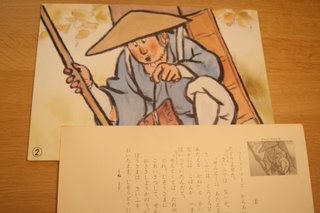
Kamishibai means "paper theater". In the old days, a kamishibai man would park his bicycle in a neighborhood to sell candy and tell a story. Allen Say wrote a book called Kamishibai Man. It is a very good story and the pictures are excellent.
A couple of years ago, I read in a magazine that a storyteller told stories using kamishibai in an area called Asakusa in Tokyo. It was done for tourists in the summer months. There may be kamishibai men in some villages. There isn't one in our neighborhood.
Kamishibai is used at libraries, at schools and at home. This is the kamishibai that we can borrow from our local library. The librarian puts the wooden theater and storycards in a bag to protect it. It also makes it easier to carry home. The white lettering on this blue bag says "kamishibai" in hiragana. All of the stories are written in hiragana, the first letters that children learn.
Most children learn it before kindergarten. While I was at the library looking through the storycards today, a small girl was reading a story to her mother. The child was sitting on the floor in front of a stool holding just the cards up in front of her mother. I wish I had had my camera!
For more information about kamishibai look at Kamishibai For Kids or The International Association for Kamishibai. The sites are in English.
May 16, 2006
Kamishibai
Posted by
Annie Donwerth Chikamatsu
at
6:33 PM
0
comments
![]()
Labels: kamishibai, May in Japan
Kamishibai Theater

This is the kamishibai theater all set up and ready for storytime. The storyteller sits behind the theater so that she can read the storycards. There is a big section in the library of kamishibai storycards. Our library only has two wooden theaters. The story can be told without the theater.
Posted by
Annie Donwerth Chikamatsu
at
6:25 PM
0
comments
![]()
Labels: kamishibai, May in Japan
Kamishibai Story Cards

The cards are put in the wooden theater. The title card is #1. After the title is announced, card #1 is slipped out and placed in back of all the cards in the theater. The first part of the story is written on the back of card #1. The Kamishibai Man or storyteller reads this as the audience is looking at the picture on card #2. The back of card #1 has the words that go with the picture on card #2. See the card with the small black and white picture with the Japanese writing next to it? That is the back of the title page. It is the first part of the story and it goes with the picture that has a #2 on it. Instead of flipping pages, the storyteller flips the cards out of the wooden theater after reading them. He puts them at the back behind the other cards.
Posted by
Annie Donwerth Chikamatsu
at
5:25 PM
0
comments
![]()
Labels: kamishibai, May in Japan
May 14, 2006
Allen Say's Visit

Allen Say has illustrated and written many picture books that feature Japanese subjects. He visited a group of children's writers, SCBWI, today in Tokyo. I have admired his work for a long time, and it was an honor to listen to what he had to say. I took this picture while he was talking because I didn't know if there would be time afterwards. There was time but I spent it getting three of my children's books autographed. His new book is called Kamishibai Man. I have posted the kamishibai that we borrow from the library. You can also have a look at Kamishibai For Kids or The International Association for Kamishibai.
Our local library here has several of Allen Say's books in English. We checked them out many times over the years. We also had our own copies of some of his other books. Big Sister and Little Brother were happy when I showed them that he had signed their books. Baba and Aunt (they live downstairs) were impressed by his books.
(I got his permission to post this picture).
Posted by
Annie Donwerth Chikamatsu
at
5:36 PM
0
comments
![]()
Labels: authors, books, kamishibai, May in Japan






